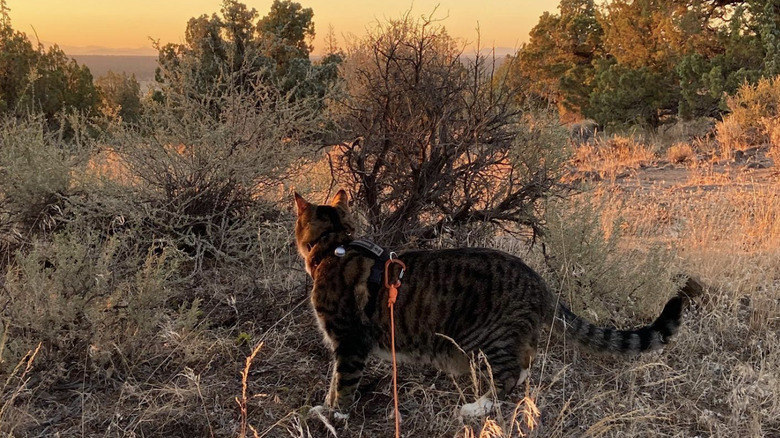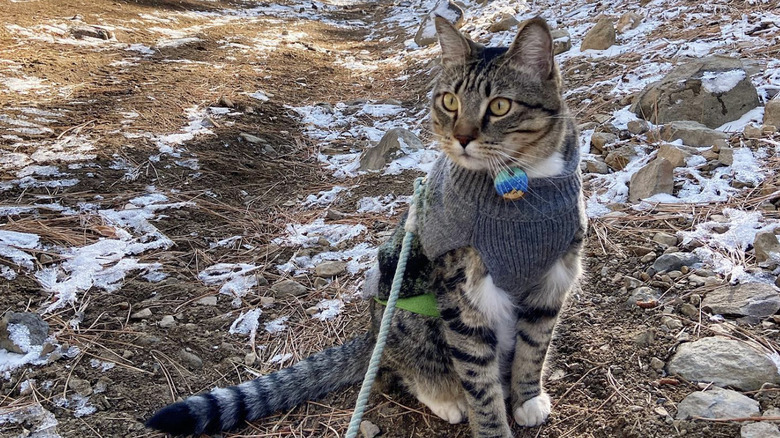How To Train Your House Cat To Be A Hiking Cat
While you are probably used to seeing people with dogs on the trail, seeing a cat wearing a harness and hiking with its owner may surprise you. However, this sight is becoming more and more common as more cat owners are starting to turn their house cats into "adventure cats." Some famous examples include "catfluencers" like Suki, the Bengal cat who goes hiking and canoeing with her family and even spent a month in Europe visiting 11 different countries. Not to mention, Rico, the Siamese cat who got his own PBS special after doing part of the Appalachian Trail with his owner in 2019.
So, adventure cats are in. And why not? Our feline companions enjoy outdoor time just as much as dogs and also require plenty of exercise and stimulation to prevent boredom. While the traditional solution to a bored cat is to simply let them outside, we now know that when cats are given free rein in a neighborhood it can take a toll on the environment. So, instead, try teaching your cat to go hiking with you.
The question is, how in the world do you do that? Cats are notorious for only doing as they please. But, as it turns out, there is a way to train your cat to hike. While it will take plenty of patience, it is a rewarding experience — both for you and your fluffy best friend.
Step 1: Consider your cat's health and personality
Before you start training your cat to hit the trails, you have to consider your specific pet's health and temperament. Usually, younger cats are easier to train because they are more open to new experiences than older cats who are used to their cozy lifestyle and may not welcome suddenly being forced outside. If your cat is generally playful and seems interested in the outdoors, then they may enjoy learning to be a trail cat. However, you are the only one who knows your cat and can determine if they will enjoy hiking or not.
Once you've decided that your cat will probably like hiking, you need to see if your fluffy pal's health is up to par. It's a good idea to go ahead and take your cat for a check-up and to discuss any previous health issues with your vet before getting started. Because your cat will be spending more time outside, it is also important to make sure they are up to date on any vaccines and flea medication. Also, you should make sure that your kitty is microchipped and has a registered number so that you can get your pal back if they ever get lost while adventuring.
Step 2: Harness and leash train your kitty
After you've evaluated whether your cat would like to hike and is healthy enough, you can start getting them used to wearing a harness and leash. Having a harness for your hiking buddy is important because cats can easily slip out of a regular collar. Also, if your cat gets excited and starts to chase a bird, you don't want them to accidentally clothesline themselves once they reach the end of their rope. With a chest harness, that won't happen. However, if you've ever tried to put a Halloween costume on your cat, you probably already know that they aren't too thrilled about wearing things that wrap around their belly. Because of this, you will have to spend some time getting your cat used to wearing the harness before taking them outside.
To do this, first, simply leave the harness out in the open so your cat can sniff it and get used to having it around. Then, you can try putting the harness on your cat. The first few times, your cat may freeze or walk weirdly while wearing it. However, after a while, your cat should start getting used to the harness and you can start to slowly increase the time your kitty spends wearing it. Once your cat is comfortable with the harness, you can attach the leash and start taking them for walks inside the house.
Step 3: Explore your yard and neighborhood
Once your cat is used to wearing a harness and being on a leash, you can start venturing outdoors. Because cats can be a little uncertain about new places and experiences, it's a good idea to start slow. First, take your cat for a leashed walk around your yard. Let them explore and sniff where they see fit as they get used to being outside.
Next, you can level up by training your cat to go in the direction you want it to. It is important to know that you should never pull on your cat with the leash as this will just confuse them and make them dislike the experience. Instead, you can get your cat to follow you or walk beside you by rewarding them with plenty of attention and treats when they do so. Once you've achieved this, you can start taking your cat on walks around your local neighborhood or park. However, at this point, it is still a good idea to stay away from busy roads and areas that will likely have dogs (if your cat isn't fond of canines).
Step 4: Get the necessary gear
As you continue to take your cat on walks and start getting further away from home (or even trying out your first local trail), it will be important to have the right gear. If you are hiking in warm weather, you should consider what sort of extra things you may need to bring to keep your cat from overheating — from a cooling vest to a water container. While some cats will drink water from a bowl while outside, others are a little more particular and you may need to experiment with different options before you find one that works and keeps your cat hydrated.
Also, while choosing the right backpack can be complicated and it's easy to get overwhelmed by all the options, getting a good cat backpack is an important part of hiking with your furry friend. A cat backpack or wearable carrier acts as a safe space for your cat if they ever get spooked or encounter an animal they want to stay away from (like a well-meaning but excited dog). For this, you will likely need a backpack that is large enough for your pet to lie down in comfortably, has a window or mesh screen they can see out of, and has a leash tether to keep your cat secure inside as you walk. Having plenty of pockets to hold water, treats, and snacks is also a plus.
Step 5: Choose the right trail and keep your cat safe
Now, you are ready to hike with your fluffy best friend and it's time to choose a trail. As your cat is likely a newly ordained adventure cat, it is best not to overwhelm them with a difficult trek. Instead, find a trail that is relatively short and not too crowded. This will be more enjoyable for your cat as they explore new smells, sights, and sounds without worrying about other people or animals.
Cats get tired more quickly than humans, so you will likely need to pick up your cat and carry him or her for at least part of the hike. For this reason, you should also choose a trail with easy terrain. This will allow your cat to walk further instead of simply being carted around in his or her carrier. Remember that cats are slow and easy hikers, and even veteran adventure cats may not be able to tackle the world's most dangerous hiking spots. Furthermore, whenever you are bringing your cat on an adventure, you should always pack some medical supplies and a first aid kit in case of emergencies. You should also make sure that you have the number of your local veterinary hospital saved in your phone.
Finally, before you venture out on a hike with your cat, keep in mind they may not be allowed on all trails. Only a few national parks allow dogs on their trails, and that rule may apply to cats as well.





